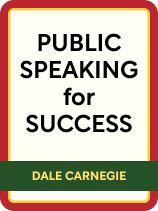

This article is an excerpt from the Shortform book guide to "Public Speaking for Success" by Dale Carnegie. Shortform has the world's best summaries and analyses of books you should be reading.
Like this article? Sign up for a free trial here.
What message do you send when you open a speech with an apology? Should you speak conversationally, or is that too informal?
In Public Speaking for Success, Dale Carnegie shares practical tips on how to deliver a powerful speech. Specifically, he discusses how to start strong, get and hold your audience’s attention, and close in a memorable way without dragging things out.
Keep reading to learn how to deliver a speech that will leave an impact.
Opening Your Speech
Carnegie’s advice on how to deliver a speech begins with recommendations for engaging and captivating your audience right from the start. The secret is simple: Deeply feel what you have to say, then speak from your heart rather than your head.
Having prepared ahead of time, you’ve learned your topic thoroughly and gotten all the facts straight. However, facts don’t convince—emotion does. So when it’s time to deliver, do so with passion, emotion, and great enthusiasm. If you haven’t built a strong emotional investment in your speech, your audience will notice and quickly lose interest—people can tell when you don’t really care about what you’re saying.
In more practical terms, Carnegie recommends the following tactics for successfully opening your speech:
- Pump yourself up. Right before your speech, get energized. Jump around, shake your fists in the air—feel your convictions and allow them to animate you and fire you up.
- Stand tall and act confident. Take the stage with poise and presence, and remind yourself that you are well-prepared, invested in your ideas, and here to educate an audience that came to listen to you.
- Cater to the audience. If they’re technical, you can open with familiar in-group words and ideas, like a Richard Feynman joke for a group of physicists.
Hook the Audience’s Attention
Beyond the above general advice, Carnegie explains that you must hook an audience’s attention. People are generally impatient, so you have to grab their attention very quickly—and this is best achieved with an opening that you design in advance to maximize your chance of success. Carnegie gives the following techniques:
- Keep it succinct. Refine your opening to a sharp, powerful sentence or two at max. Then charge ahead into your speech.
- Arouse curiosity. People are naturally curious—take advantage of their desire to know more with a shocking statement, novel information, or a captivating question.
- Appeal to self-interest. If your audience is practical or business-oriented, tell them how what you have to say will improve their lives or bottom lines.
- Find common ground. When your topic is contentious, open by tactfully speaking to shared experiences, values, or points of reference between you and the audience. This gives them a positive first impression and ensures they’ll listen to what you have to say.
Beyond what to do, Carnegie says, you can also improve your opening by avoiding the following common (and often ruinous) errors:
- Opening with an apology. Often used to seem humble, this technique makes speakers look incompetent or unprepared and can annoy audiences.
- Opening with humor. Most speakers can’t pull off jokes, so you’ll most likely make the audience cringe and pull away emotionally.
- Opening too formally. Scripted, overly rehearsed, and/or dry openings easily lose the audience’s attention.
Holding the Audience’s Attention
Once you’ve hooked the audience’s attention, you need to continue to earn it. According to Carnegie, you can do this by paying attention to how you speak and not just what you say. While he states that there are no hard-and-fast rules, Carnegie does recommend these techniques:
- Speak conversationally, as if you’re chatting with a close friend. This will bring out a natural, sincere quality in your voice and help the audience feel connected to you.
- Speak to individuals, not the crowd. After all, the audience is composed of individuals, and people generally appreciate being recognized and spoken to. Make eye contact; create connections.
- Let loose your individuality. Real stage presence comes from an authentic individual owning their personality. To truly own the stage, speak, move, and express yourself in whatever way feels most natural.
Remember also that your attitude influences your audience’s attitude—that is, they respond to the emotion you give off. To avoid appearing uncomfortable or awkward, stand tall and keep your hands relaxed at your sides. Let yourself gesture naturally, but avoid sharp or jerky movements. All in all, practice speaking spontaneously, authentically, and as only you can.
Closing Your Speech
To close a speech in a memorable way, leave the audience with a final, powerful, and clear restatement of your argument’s main thrust. According to Carnegie, there’s no perfect prescription for achieving this. You won’t do it that well in your first few speeches, but, over time, you’ll develop a sense of when your point is clear and when the timing is right to end.
Generally, that point comes not long after the peak, or climax, of your speech. That is, once you’ve landed on the main, cumulative thrust of your argument, start looking to wrap the speech up. This works because you’ll stop while your audience is still enjoying your speech and leave them wanting more. If, in contrast, you drag things out, you’ll lose their interest.
Carnegie asserts that since endings are so important, you should plan yours out word for word. Write it out ahead of time, revise it, and try it out on friends and family to get feedback. Keep revising it and getting feedback until your helpers clearly feel roused by the ending. As you’re crafting your ending, consider Carnegie’s five techniques:
- Recap your argument. This refreshes your logic in the audience’s minds and helps them put the whole thing together.
- Call for action. Having made your argument, make a passionate statement as to what needs to be done about your topic.
- Thank your audience. If you sincerely feel it, express your pleasure, gratitude, or enjoyment at speaking for them.
- Use a famous quote. If a famous quote more powerfully sums up your argument than you could, take advantage of that fact.

———End of Preview———
Like what you just read? Read the rest of the world's best book summary and analysis of Dale Carnegie's "Public Speaking for Success" at Shortform.
Here's what you'll find in our full Public Speaking for Success summary:
- Why public speaking is one of the most important skills to have
- How to overcome the fear of public speaking and adopt poise
- How to research, write, and deliver a memorable speech






